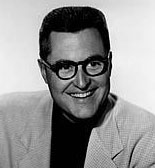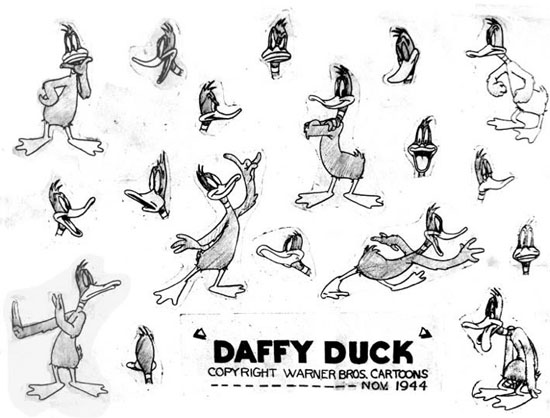
Shortly after animation director Bob McKimson’s death September 29, 1977, I had the opportunity to talk with animation legend Bob Clampett about McKimson. When interviewing animators, I found that it is often valuable to ask about the people they worked with to get a different perspective or to simply just get some basic information because some of those people were never interviewed before their deaths.
 Jim Korkis: When did you first meet Robert and Tom McKimson?
Jim Korkis: When did you first meet Robert and Tom McKimson?
Bob Clampett: I was working with Harman and Ising on the Merrie Melodies, and we were starting to animate on the third one when Hugh Harman came down and personally told us that Bob and Tom would be joining us. Naturally we were curious about what these guys were like, but we never expected what a grand entrance they would make. The first morning they came in, they marched right in on the dot. They marched right in as if in perfect step, went to their desks, took off their coats, and sat down exactly at eight o’clock and started to work. This was all very spectacular, like a Busby Berkeley routine. They were dressed in polo outfits, which were very flashy-type outfits back then, and they had the breeches and boots and so forth. They also wore a black camel’s hair coat and I believe a black beret.
JK: Did they have a different style of animating?
BC: They had a different way of animating than we had seen before. They were much more organized than most of the guys at the studio. Some of us called them “The Mechanical McKimsons” because they could turn out a tremendous amount of animation very quickly, almost as if they had a blueprint in their mind that they were just tracing onto the paper. This was particularly true of Bob. He would sit down and be able to produce very clean drawings with little if any of the guidelines most of the rest of the artists needed to use.
JK: That sounds remarkable.
BC: He could make a final detailed drawing of a character without first sketching in a single rough guide line. It was as if he was tracing an invisible drawing starting at the top and on down to the bottom with the greatest precision. I would always earmark the most difficult, under-played acting scenes of Bugs Bunny for him. And when I gave him his scenes, I never felt it necessary to make as many layout sketches and action roughs as I made for the other animators. I would mainly stand up and act out each action for him with each little facial expression, finger action, etc. as he stared intently at me. Sometimes he would ask me to go through it two or three more times and then he would go to his board and return with a fully animated set of drawings so exact to what I hoped to see that you would swear he had in some way photographed them in his head and miraculously xeroxed them on to the sheets.
JK: Did anything ever slow him down?
BC: Nothing. Bob was very popular with the girls, so sometimes he’d be out real late at night. The next morning he would come in right on the dot but maybe take a quick nap with his head on the desk. When he got up and started to work, it ended up that he would turn out almost twice as much work as anybody else that day.

JK: Now were you also animating at the same time as the McKimsons?
BC: Bob and Tom were first-rate animators at that time, while I was still sort of flubbing along. They were doing big, important jobs on the pictures. You could just look at their drawings and tell they were different. They’d make “x’s” on any area that was supposed to be colored in black, and they would use red lines to indicate a grey line, and so forth. They did nice things with their drawings that other people never got around to or never thought to do. They were distinctive.
JK: What type of training did they have before Warners?
BC: Well, I’m not sure of all of it. I’d have to look it up and check, but I remember them telling me that their dad had been in the printing business and they may have worked in the printing shop. I think some of that type of training affected their thinking and their organization. For example, Bob and Tom would have little stamps made up, and nobody else had this. They had little stamps saying things like “Scene Number” or “Retrace this drawing” and other things.
JK: What did you think of Bob McKimson’s animation?
 BC: I thought he was a marvelous animator. He moved them around well in those days, but he didn’t have the warmth or the personality in the characters that you see in the great things he did on Bugs Bunny later. To me, their animation was very distinctive, but of course I was there seeing them draw it, and it made an impression on me. I think some of the others at the studio may have thought they were a little, well, conservative in their style of drawing. But even that kind of thinking wouldn’t faze Bob. He wasn’t one to clown around.
BC: I thought he was a marvelous animator. He moved them around well in those days, but he didn’t have the warmth or the personality in the characters that you see in the great things he did on Bugs Bunny later. To me, their animation was very distinctive, but of course I was there seeing them draw it, and it made an impression on me. I think some of the others at the studio may have thought they were a little, well, conservative in their style of drawing. But even that kind of thinking wouldn’t faze Bob. He wasn’t one to clown around.
JK: What did you think of Bob McKimson’s direction?
BC: I always felt that Bob was too great an animator to leave animation–even for direction. But, direct he did, and he always spoke proudly to me of his having first introduced Speedy Gonzales to the screen and the Tasmanian Devil and of course, Foghorn Leghorn, which he told me he had patterned after a voice that he had first heard of local radio called “Dynamite Gus” which the same actor, Kenny Delmar, later performed on network radio as Senator Claghorn. I feel very badly that he has been ignored and I’m very glad you asked me about him. The emotional reaction at universities and fan conventions when I tell about Bob is overwhelming and that makes me very happy.



 Jim Korkis is an internationally respected animation historian who in recent years has devoted his attention to the many worlds of Disney. He was a columnist for a variety of animation magazines. With his former writing partner, John Cawley, he authored several animation related books including The Encyclopedia of Cartoon Superstars, How to Create Animation, Cartoon Confidential and Get Animated’s Animation Art Buyer’s Guide. He taught animation classes at the Disney Institute in Florida as well as instructing classes on acting and animation history for Disney Feature Animation: Florida.
Jim Korkis is an internationally respected animation historian who in recent years has devoted his attention to the many worlds of Disney. He was a columnist for a variety of animation magazines. With his former writing partner, John Cawley, he authored several animation related books including The Encyclopedia of Cartoon Superstars, How to Create Animation, Cartoon Confidential and Get Animated’s Animation Art Buyer’s Guide. He taught animation classes at the Disney Institute in Florida as well as instructing classes on acting and animation history for Disney Feature Animation: Florida.




















































I’ll agree with what Bob Clampett said…it is a shame that McKimson is so often ignored or dismissed when people discuss the Warner Bros. cartoons. He has a distinctive style and drew many of the famous publicity drawings that were used for years after the WB animation studio closed up shop. While Freeleng got sloppy and Jones was caught up in his own stylized sketchy look for the characters in later years. McKimson was still drawing the most on-model version of Bugs Bunny at the studio (although I know that to some in the creative industry “on model” is a term that makes them cringe, there is something to be said for someone who can draw a Bugs Bunny that looks like a finished Bugs Bunny and not a zeroxed storyboard sketch).
Agreed as well, Deb!
Agreed as well. I blame in part those terrible Blue Ribbon reissues and posturing by Jones to increase his reputation and the expense of his peers.
I think much of his fortunes and success as a director came down to being “lumped” with Tedd Pierce who was clearly the weakest of the 3 writers (together with Mike Maltese and Warren Foster who was with Bob).
Great interview. McKimson’s drawings are so incredibly clean and clear, and as a cartoonist myself, that’s a tough thing to do. And to do it without roughing anything out first?! Forget it!
I’m kinda late on this, but I would encourage everybody to get Robert McKimson Jr.’s book “I Say, I Say… Son!,” published late last year, about his father and uncles. It’s excellent, and gives us a great insight into one of the greatest animators and cartoon directors ever. (One of my Top Five Favorite Funniest Cartoons I’ve Ever Seen is McKimson’s “Hillbilly Hare.”)
“Daffy Duck Slept Here” is one of McKimson’s best. I laugh every time.